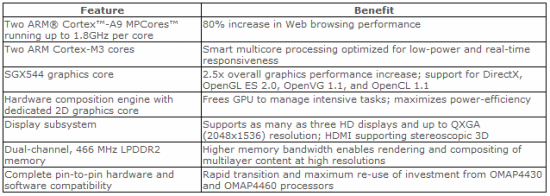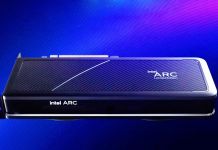Texas Instruments has updated its family of ARM system processors and the new OMAP4470 SoC is exciting in so many ways. With the Cortex-A9 CPU-base architecture the circuits brings two cores with clock frequencies up to market leading 1.8 GHz. It also has an all fresh PowerVR SGX544 GPU with DirectX9 support just waiting for Windows 8.
OMAP4470 is exected to appear as samples in the second half of 2011, but shouldn’t appear in any products until next year. With frequencies turned up high on the CPU and considerably more powerful GPU it has created a really interesting SoC, not the least for Windows 8.
Texas Instruments has beside the two 1.8 GHz Cortex-A9 cores packed in two Cortex-M3 cores clocked at 266 MHz that will help when playing video and other multimedia functionality, which should lower power consumption overall.
When it comes workloads like browsing and other CPU-intensive applications TI speak of a performance improvement of up to 80% compared to OMAP4430, which is a direct result of the increase in frequency.

Extra interesting is the Imagination Technologies PowerVR SGX544. This is a close sibling to the SGX543MP2 GPU that Apple uses in its Apple A5 system processor, but here we “only” get a single GPU core with up to 2.5 time the performance of the SGX540 GPU used in OMAP4430. What makes SGX544 different from the sibling in Apple A5 is the support for Microsoft’s API DirectX9. Apple doesn’t care for this for obvious reasons, but after Microsoft’s preview of Windows 8 Texas Instrument has a good weapon for next year’s system processor war.
Exactly how much Microsoft will rley on DirectX in the ARM version of Windows 8 is uncertain, but it is not a bad guess that TI has been informed that a support for DirectX will be an advantage when Windows 8 rolls out on tablets and other energy efficient systems next year.
The GPU will also be supported by a dedicated circuit for 2D rendering and powering the HD interface, and similar functioality.
We will follow the development on the ARM market and not the least see how the circuit manufacturers adopt Microsoft’s coming platform Windows 8.















